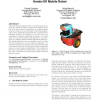HRI
2006
ACM
14 years 5 months ago
2006
ACM
We present a method of grounded word learning that is powerful enough to learn the meanings of first and second person pronouns. The model uses the understood words in an utteran...
HRI
2006
ACM
14 years 5 months ago
2006
ACM
This paper presents results toward our ongoing research program into hands-off assistive human-robot interaction [6]. Our work has focused on applications of socially assistive r...
HRI
2006
ACM
14 years 5 months ago
2006
ACM
Robot programmers are faced with the challenging problem of understanding the robot’s view of its world, both when creating and when debugging robot software. As a result tools ...
HRI
2006
ACM
14 years 5 months ago
2006
ACM
This paper reports on a study of human participants with a robot designed to participate in a collaborative conversation with a human. The purpose of the study was to investigate ...
HRI
2006
ACM
14 years 5 months ago
2006
ACM
HRI
2006
ACM
14 years 5 months ago
2006
ACM
Polymorphic, or shape-shifting, robots can normally tackle more types of tasks than non-polymorphic robots due to their flexible morphology. Their versatility adds to the challeng...
HRI
2006
ACM
14 years 5 months ago
2006
ACM
Humanoid robots offer many physical design choices such as voice frequency and head dimensions. We used hierarchical statistical mediation analysis to trace differences in people�...
HRI
2006
ACM
14 years 5 months ago
2006
ACM
In order for humans and robots to work effectively together, they need to be able to converse about abilities, goals and achievements. Thus, we are developing an interaction infr...
HRI
2006
ACM
14 years 5 months ago
2006
ACM
There is growing interest in mining the world of video games to find inspiration for human-robot interaction (HRI) design. This paper segments video game interaction into domain-i...
HRI
2006
ACM
14 years 5 months ago
2006
ACM
This paper investigates human behavior around an interactive robot at a science museum. To develop a communication robot that works in daily environments, it is important to inves...



